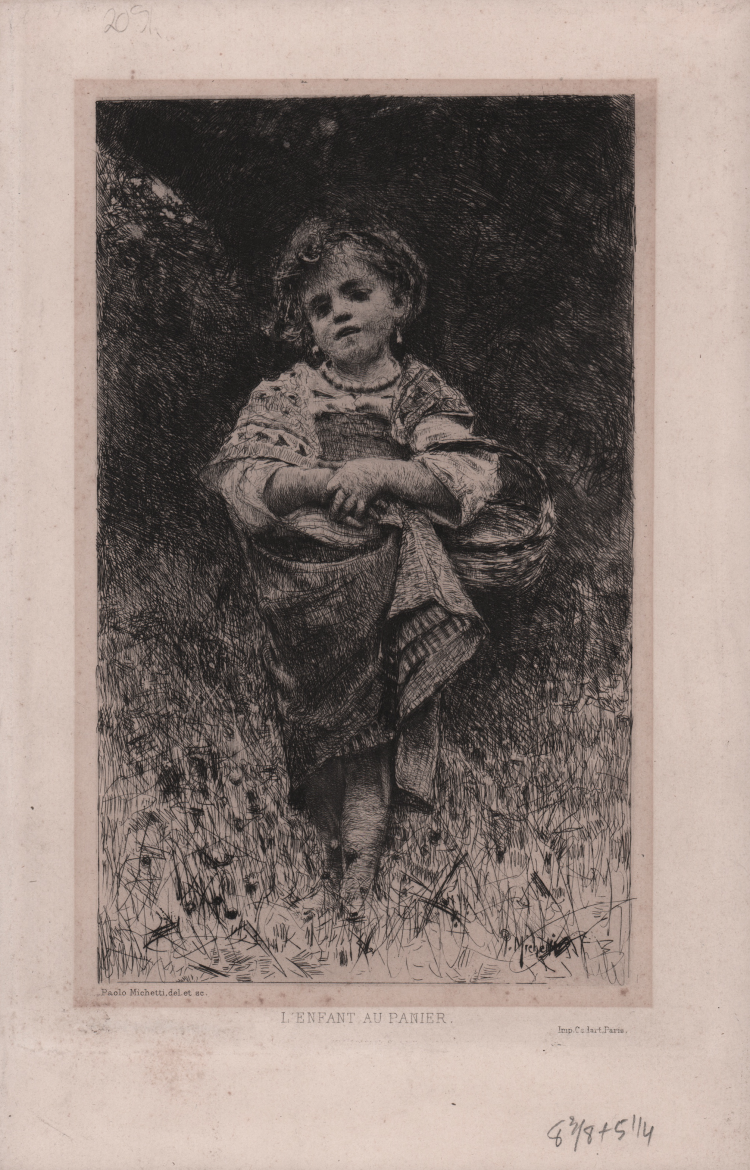



| Reference: | S42109 |
| Author | Francesco Paolo MICHETTI |
| Year: | 1880 ca. |
| Measures: | 155 x 235 mm |


| Reference: | S42109 |
| Author | Francesco Paolo MICHETTI |
| Year: | 1880 ca. |
| Measures: | 155 x 235 mm |
Etching, circa 1880, signed in plate at bottom.
Exemplar in the fifth state of six, with Cadart's address.
Beautiful proof, impressed on coeval laid paper, with margins, in good condition.
A little girl in traditional clothes walks frontally towards the viewer. The figure is in full light, stands out against a background of dense brushwood, powerful is the use of chiaroscuro that knows the lesson of Rembrandt. The child has her arms resting on her stomach to hold a basket, the wavy hair frames her face, it seems that she is humming and the detail of the earrings and the pearl necklace accentuate the brightness of her complexion. The subject is already addressed in painting, particularly in the painting La Petite Fille au panier on the Paris market in 1875 as belonging to the H collection. In the sale catalog, the painting is illustrated with Michetti's engraving, which therefore constitutes a terminus ante quem for the dating of the plate. The figure is constructed with Michetti's typical fine and free mark, a scratched, elegant mark; the volumes are constructed with a dense and irregular interweaving of delicate strokes and dots, successive morsure progressively marking the areas in shadow.
Signature in the lower right corner of the plate P Michetti. In the lower margin beyond the image on the left "Paolo Michetti del. et sc.", title in the center, on the right "Imp.Cadart, Paris" and on the left "Gazzette de Beaux-Arts".
The copy is taken from La Gazette des Beaux-arts issue of March 1880.
Francesco Paolo Michetti (1851 – 1929) learned painting's rudiments from a local fresco painter. In 1868 he traveled to Naples, supported by a small grant to study at the academy there. Asserting that his temperament would benefit more from real life situations, he was allowed to return to the Abruzzo region in 1869 and continued to receive his grant. Michetti exhibited at the Paris Salons of 1872 and 1875, but he also belonged to Scuola di Resina, a group of Neapolitan painters that aimed to bring Italian art into Europe's mainstream. Abruzzo was his emotional and aesthetic inspiration. He captured its people, animals, and local events in emotionally charged paintings with luminous colors and vibrant light. In 1883 Michetti purchased a convent as his home and studio. For the next twenty years, the convent was a meeting place for Abruzzo's artists and exponents of culture, including writer Gabriele D'Annunzio. Michetti's 1895 Daughter of Iorioinspired D'Annunzio's 1904 tragedy, for which Michetti designed the sets and costumes. From 1872 onward, Michetti also produced small, decorative clay sculptures. After a lukewarm response to his paintings at the 1900 Exposition Universelle in Paris, he abandoned painting, sold his studio, and generally lived as a recluse.
|
Bibliografia: Davoli, 5; Prandi 4 (ill.); V. Bindi, Artisti abruzzesi, Napoli 1883, pp. 172-176; G. D’Annunzio, Nota su F.P. M., in Convito, VIII (1896), pp. 583-592; R. De Logu, Per un profilo di M., in Mostra dei disegni, incisioni e pastelli di F.P. M.
|
Francesco Paolo MICHETTI(Tocco da Casauria 1851 – Francavilla al Mare 1929)
|
Bibliografia: Davoli, 5; Prandi 4 (ill.); V. Bindi, Artisti abruzzesi, Napoli 1883, pp. 172-176; G. D’Annunzio, Nota su F.P. M., in Convito, VIII (1896), pp. 583-592; R. De Logu, Per un profilo di M., in Mostra dei disegni, incisioni e pastelli di F.P. M.
|
Francesco Paolo MICHETTI(Tocco da Casauria 1851 – Francavilla al Mare 1929)